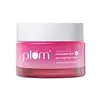Bioderma Atoderm Ultra Cream Versus Plum Goodness Bulgarian Rose & 1% Hyaluronic Acid Dew-It-Light Gel Cream
What's inside
What's inside
 Key Ingredients
Key Ingredients

 Benefits
Benefits

 Concerns
Concerns

 Ingredients Side-by-side
Ingredients Side-by-side

Water
Skin ConditioningParaffinum Liquidum
EmollientGlycerin
HumectantBrassica Campestris Seed Oil
Skin ConditioningSodium Polyacrylate
AbsorbentPentylene Glycol
Skin ConditioningCetearyl Alcohol
Emollient1,2-Hexanediol
Skin ConditioningCaprylyl Glycol
EmollientAcrylates/C10-30 Alkyl Acrylate Crosspolymer
Emulsion StabilisingSodium Citrate
BufferingXylitol
HumectantCetearyl Glucoside
EmulsifyingMannitol
HumectantTocopherol
AntioxidantRhamnose
HumectantXylitylglucoside
HumectantHelianthus Annuus Seed Oil
EmollientAnhydroxylitol
HumectantNiacinamide
SmoothingGlucose
HumectantFructooligosaccharides
HumectantCaprylic/Capric Triglyceride
MaskingLaminaria Ochroleuca Extract
Skin ConditioningWater, Paraffinum Liquidum, Glycerin, Brassica Campestris Seed Oil, Sodium Polyacrylate, Pentylene Glycol, Cetearyl Alcohol, 1,2-Hexanediol, Caprylyl Glycol, Acrylates/C10-30 Alkyl Acrylate Crosspolymer, Sodium Citrate, Xylitol, Cetearyl Glucoside, Mannitol, Tocopherol, Rhamnose, Xylitylglucoside, Helianthus Annuus Seed Oil, Anhydroxylitol, Niacinamide, Glucose, Fructooligosaccharides, Caprylic/Capric Triglyceride, Laminaria Ochroleuca Extract
Water
Skin ConditioningGlycerin
HumectantDimethicone
EmollientRosa Damascena Flower Water
MaskingBetaine
HumectantXylitol
HumectantInulin
Skin ConditioningInositol
HumectantCaprylyl Methicone
Skin ConditioningPEG-12 Dimethicone/PPG-20 Crosspolymer
Sodium Hyaluronate Crosspolymer
HumectantSodium Hyaluronate
HumectantSodium Acetylated Hyaluronate
HumectantHydrolyzed Sodium Hyaluronate
Skin ConditioningPentylene Glycol
Skin ConditioningSaccharide Isomerate
HumectantCyclodextrin
AbsorbentSqualane
EmollientPanthenol
Skin ConditioningCitric Acid
BufferingSodium Citrate
BufferingAmmonium Acryloyldimethyltaurate/Vp Copolymer
Sorbitol
HumectantLinoleamidopropyl Pg-Dimonium Chloride Phosphate
Ammonium Acryloyldimethyltaurate/Beheneth-25 Methacrylate Crosspolymer
Emulsion StabilisingPhenoxyethanol
PreservativeEthylhexylglycerin
Skin ConditioningSodium Hydroxide
BufferingSodium Gluconate
Skin ConditioningParfum
MaskingCI 17200
Cosmetic ColorantWater, Glycerin, Dimethicone, Rosa Damascena Flower Water, Betaine, Xylitol, Inulin, Inositol, Caprylyl Methicone, PEG-12 Dimethicone/PPG-20 Crosspolymer, Sodium Hyaluronate Crosspolymer, Sodium Hyaluronate, Sodium Acetylated Hyaluronate, Hydrolyzed Sodium Hyaluronate, Pentylene Glycol, Saccharide Isomerate, Cyclodextrin, Squalane, Panthenol, Citric Acid, Sodium Citrate, Ammonium Acryloyldimethyltaurate/Vp Copolymer, Sorbitol, Linoleamidopropyl Pg-Dimonium Chloride Phosphate, Ammonium Acryloyldimethyltaurate/Beheneth-25 Methacrylate Crosspolymer, Phenoxyethanol, Ethylhexylglycerin, Sodium Hydroxide, Sodium Gluconate, Parfum, CI 17200
 Reviews
Reviews

Ingredients Explained
These ingredients are found in both products.
Ingredients higher up in an ingredient list are typically present in a larger amount.
Glycerin is already naturally found in your skin. It helps moisturize and protect your skin.
A study from 2016 found glycerin to be more effective as a humectant than AHAs and hyaluronic acid.
As a humectant, it helps the skin stay hydrated by pulling moisture to your skin. The low molecular weight of glycerin allows it to pull moisture into the deeper layers of your skin.
Hydrated skin improves your skin barrier; Your skin barrier helps protect against irritants and bacteria.
Glycerin has also been found to have antimicrobial and antiviral properties. Due to these properties, glycerin is often used in wound and burn treatments.
In cosmetics, glycerin is usually derived from plants such as soybean or palm. However, it can also be sourced from animals, such as tallow or animal fat.
This ingredient is organic, colorless, odorless, and non-toxic.
Glycerin is the name for this ingredient in American English. British English uses Glycerol/Glycerine.
Learn more about GlycerinPentylene glycol is typically used within a product to thicken it. It also adds a smooth, soft, and moisturizing feel to the product. It is naturally found in plants such as sugar beets.
The hydrophilic trait of Pentylene Glycol makes it a humectant. As a humectant, Pentylene Glycol helps draw moisture from the air to your skin. This can help keep your skin hydrated.
This property also makes Pentylene Glycol a great texture enhancer. It can also help thicken or stabilize a product.
Pentylene Glycol also acts as a mild preservative and helps to keep a product microbe-free.
Some people may experience mild eye and skin irritation from Pentylene Glycol. We always recommend speaking with a professional about using this ingredient in your routine.
Pentylene Glycol has a low molecular weight and is part of the 1,2-glycol family.
Learn more about Pentylene GlycolSodium Citrate is the sodium salts of citric acid. In skincare, it is used to alter pH levels and acts as a preservative.
Its main functions are to maintain the pH of a product and neutralize metal ions.
The acidity of our skin is maintained by our glands and skin biome; normal pH level of skin is slightly acidic (~4.75-5.5).
Being slightly acidic allows our skin to create an "acid mantle". This acid mantle is a thin barrier that protects our skin from bacteria and contaminants.
Learn more about Sodium CitrateWater. It's the most common cosmetic ingredient of all. You'll usually see it at the top of ingredient lists, meaning that it makes up the largest part of the product.
So why is it so popular? Water most often acts as a solvent - this means that it helps dissolve other ingredients into the formulation.
You'll also recognize water as that liquid we all need to stay alive. If you see this, drink a glass of water. Stay hydrated!
Learn more about WaterXylitol is a humectant and prebiotic. It can help with dry skin.
In studies, xylitol has been shown to improve dry skin. It decreased transepidermal water loss, or when water passes through the skin and evaporates. Xylitol also showed to help improve the biomechanical properties of the skin barrier.
The prebiotic property of xylitol may also help reinforce our skin's natural microbiome. Having a healthy microbiome prevents infection by bad bacteria and helps with hydration.
As a humectant, Xylitol helps draw moisture from both the air and from deeper skin layers. This helps keep skin hydrated.
Xylitol is a sugar alcohol and commonly used as a sugar substitute. It is naturally occurring in plants such as strawberries and pumpkin.
Learn more about Xylitol